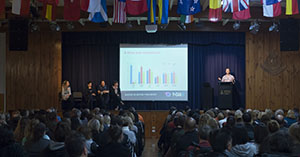
Source: iStock
Generally, young people have good knowledge about HIV. But we need to ensure that they don’t become complacent due to modern treatments.
In the early 1980s, a diagnosis of AIDS was considered a death sentence. Various treatments can now keep those living with HIV relatively healthy, which is an enormous step forward but still not a cure.
Annual new HIV infections in Victoria peaked in 1985 at more than 500 and fell to 141 in 1999. They climbed again and evened out at roughly 260 cases each year from 2006 to 2009, before falling to 228 cases in 2010 (1). The number of new cases has been relatively stable for several years.
Victorian AIDS diagnoses peaked from 1992 to 1995 (180 cases). New treatments available since the mid-1990s have seen that drop to fewer than 50 annual cases.
HIV still predominantly affects men who have sex with men.
The HIV, viral hepatitis and sexually transmissible infections in the Australia Annual Surveillance Report 2015 (2) found harm reduction among people who inject drugs had been highly successful and comprehensive medical interventions had led to extremely low maternal transmission rates.
The incidence of HIV among women involved in sex work was also extremely low due to successful safe sex promotion, frequent testing of sex workers and moves preventing HIV-positive sex workers from working in the industry. But the report also found that vigilance was still needed. The HIV diagnosis rate had also increased in the Aboriginal and Torres Strait Islander population over the past five years.
“Overall, initiatives to promote testing and HIV treatment have achieved high levels of uptake, but not yet attained global targets in regards to treatment initiation,” the report said.
Students generally have good knowledge of HIV. The fifth National Survey of Australian Secondary Students and Sexual Health 2013* found that most knew it could be transmitted by sharing needles (93 per cent), that a woman could get HIV from having sex with a man (95 per cent) and that a man could get it from having sex with a woman (90 per cent).
They know that hugging a HIV positive person could not transmit the virus (95 per cent), that men could get HIV from having sex with men (85 per cent), the contraceptive pill offers no protection against HIV for women (85 per cent) and that a pregnant woman with HIV could pass on the infection to her baby (73 per cent).
Most students knew that using condoms during sex offered some protection from HIV (83 per cent), that someone who looked healthy could still pass on HIV infection (82 per cent) and that coughing or sneezing could not transmit HIV (74 per cent).
The poorest knowledge related to mosquitoes – 69 per cent did not know that mosquitoes could not transmit the virus.
Only five per cent felt that they were “likely” or “very likely” to become infected with HIV.
What is HIV?
HIV (Human Immunodeficiency Virus) is a virus that weakens the immune system. It attacks and takes over immune cells, using them to reproduce itself. Infected cells can be found in many parts of the body and in body fluids such as blood, semen, vaginal fluid, breast milk and anal mucous.
AIDS (Acquired Immune Deficiency Syndrome) is a serious weakening of the body’s immune system caused by HIV. When an HIV-positive person’s immune cells (CD4 cells) drop below a certain level, they can be vulnerable to opportunistic infections that their body would normally fight off. AIDS can also be defined as having HIV and an opportunistic infection regardless of your CD4 count.
HIV, not AIDS, is transmitted between people. HIV is spread by unprotected sex and sharing needles and syringes. It is not passed on by kissing, hugging, saliva, sweat, tears, urine, sharing utensils or insect bites. There is no cure, but effective treatments can keep people with HIV healthier.
HIV treatment
In the mid-1990s, effective treatment for HIV infection became available in Australia. HIV is now a manageable infection, with treatment that not only controls the virus in the person but also reduces their infectiousness (though not completely).
Treatment means that HIV is no longer a gradual progression to AIDS and then death. However, many people living with HIV still deal with a range of problems and health issues because of their HIV status.
HIV prevention
Victoria has contained mother-to-child transmission and infection rates among injecting drug users, sex workers and those who receive blood transfusions. Sexual transmission is still the main cause of HIV infection. However, transmission through vaginal sex is slowly increasing, though this is often due to being from, or having sex with, someone from a country with a high HIV prevalence.
The most reliable way to prevent the sexual transmission of HIV is to use a condom, in conjunction with a water-based lubricant (petroleum-based lubricants can make condoms break). If injecting drugs, always use a clean syringe, and never share syringes.
Victorian AIDS Council // www.vac.org.au/hiv-fact-sheet
HIV in Australia
- An estimated 27,150 people in Australia are HIV positive, of whom an estimated 3350 (12 per cent) are unaware of this. HIV transmission continues to occur primarily through sexual contact between men.
- In 2014, 1081 people were diagnosed with HIV. The number of newly diagnosed HIV infections has remained stable for three years, with 1081 cases in 2014, 1028 in 2013 and 1064 in 2012.
- More than a quarter (28 per cent) of 2014 new HIV cases were diagnosed late (i.e. among people likely to have been living with HIV for at least four years without being tested).
- By December 31 2014, 35,128 cases of HIV had been diagnosed in Australia since the first diagnoses in 1982.
- The annual number of AIDS diagnoses in Australia peaked at 953 in 1994. They then declined rapidly due to effective antiretroviral therapies that delay progression from HIV to AIDS. Few people are now diagnosed with AIDS.
Of all HIV diagnoses made in Australia in 2014:
- 70 per cent occurred among men who have sex with men.
- Five per cent were attributed to either male-to-male sex or injecting drug use.
- 19 per cent were attributed to heterosexual sex.
- Three per cent were attributed to injecting drug use.
- For three per cent, the mode of transmission was undetermined.
HIV in Victoria
Victorian AIDS diagnoses peaked from 1992 to 1995 (180 cases). New treatments available since the mid-1990s have seen that drop to fewer than 50 annual cases. There were 31 cases in 2014 and 39 cases in 2015.
What is PEP?
PEP (Post-Exposure Prophylaxis) is a month-long course of drugs to help prevent HIV infection that is taken after a possible exposure to HIV. The sooner someone starts PEP the better, but it must be started within 72 hours after a possible exposure to HIV. The PEP drugs are the same drugs that HIV-positive people use to reduce its impact on their body.
For more information visit // getpep.info



